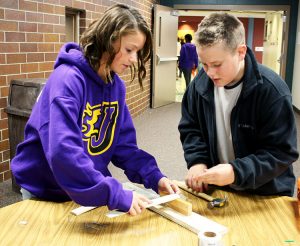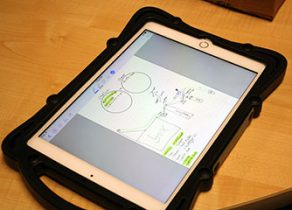Summit Students Complete a Complex Assignment Using Simple Machines
Out of all the likely ways for students to demonstrate understanding of a text, building a simple machine may be one of the last ideas to come to mind.
But that type of thinking – a little flipped and a lot nontraditional – is known as project-based learning. Shortly after the 2017-18 school year started, teachers from around the district

Summit seventh graders Rachael (left) and Conner (right) work together to build a simple machine representing interaction between literary characters.
gathered to learn more about project-based learning and how to implement it into their curriculum. The basis of project-based learning challenges students to investigate and respond to an authentic, engaging, and complex question.
It’s also exactly how Summit Middle School seventh graders are going about their final project in their language arts classes.
“We read a narrative poem called ‘The Highway Men’,” said Conner, a seventh grader. “It’s a story about how one character, Bess, fell in love with a Highway Man during the Revolutionary War. The Red Coats influenced Bess to make some bad decisions and in the end, both she and her love died. So now that we’ve read that, it’s time to build something that tells the story.”
Conner and his team member Rachael had to brainstorm a simple machine that represented how two elements in the story impacted, interacted, or shaped each other. Using tools, cardboard, wood, supplies from home, and a host of random materials, students used their iPads to sketch out concepts and then began producing their machines.
The project is finished when the teams video record an explanation of their simple machine, how it relates to the story, and a demonstration of it.
“The hardest part is thinking about what we want our simple machine to do and what we want it to represent,” said Rachael. “There’s also some challenge in the actual building, but it’s mostly fun.”
While students hammered away – literally – on pulleys, levies, wheels, ramps, wedges, and more, Matt Hiatt, Summit seventh grade language arts teacher, went from group to group to make sure students stayed on the right path.
“There’s a lot about this project that awards the trial and error process,” said Hiatt. “It’s important for students to experience these hands-on projects that force them to connect two separate concepts. In this case, it’s character relationships and a machine. One of the benefits of project-based learning are the discoveries and deeper thinking in nearly every aspect of the assignment.”
Conner and Rachael said they had not done a project like this in any other class. In addition to STEM elements of science, technology, engineering, and mathematics, Rachael said they also worked on their collaboration and communication skills.
“There are some things that didn’t work out like we planned, but we adjusted and I think our new idea will work,” said Rachael. “It’s been fun to do something so different from normal projects and final tests.”



